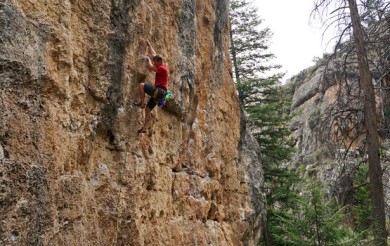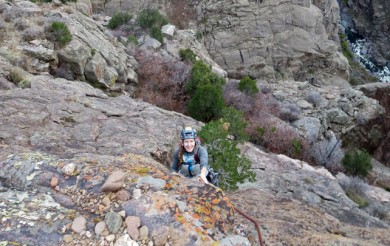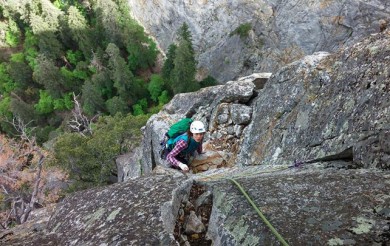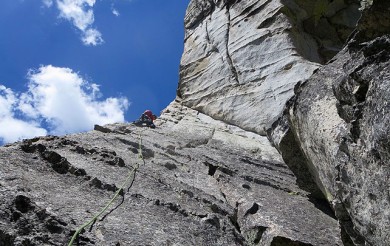Check Yo Self Before You Wreck Yo Self
How to stay safe while sport climbing
As I often share with first-timers, climbing is an incredibly safe activity, but if you make one mistake, you can die. And it’s easy to get lulled into a false sense of security, I mean how many times have you gone climbing and really had things hit the fan? Probably very few, if any, even if you’ve been at this thing for awhile.
The safety systems we have in place, like checking each other out before leaving the ground, are there to prevent anything from happening, and though if you move beyond single pitch climbing, you start to take on more objective hazards, for casual cragging the fact remains that the biggest threat to your safety is yourself.
It was sad to hear of another accident where someone died while cleaning a route in Clear Creek recently. And while the details surrounding this are still fuzzy, there are a few things you can do to stack the odds in your favor. If you implement the following systems, it’s virtually impossible to have something go wrong while cleaning a pitch, short of gear failure.
1) Have a plan when you leave the ground, whether you think you will rappel or lower. If you’ve never climbed with this particular person, make sure you know what commands you will use and what you each think they mean. Check your knot, check the belay device. If they threaded the GriGri backward and you don’t catch it, anything that happens is just as much your fault as theirs.
2) When you are the one cleaning, go in to the anchor with two independent points. Some people use a PAS for this, since we are sport climbing I usually just take some quickdraws, and clip them into my belay loop and then into each bolt. Don’t trust one bolt, even if it looks bomber. Who knows what yahoo put that thing in, maybe he forgot to tighten it down in his lust for first ascent glory.
3) If you are going to lower, NEVER SAY OFF BELAY! YOU ARE NOT OFF BELAY. I can’t tell you how many times I’ve seen this. And I always yell up, “Hey aren’t you going to lower?” At which point they usually realize their error and tell the belayer to keep them on. Belayers, double check with the climber before taking them off belay. “OK, I’m taking you off belay, you are going to rappel, right?” Also, use names. Almost all of us have been at busy cliffs where you hear an “Off Belay” from above, only to see several people at the base start taking their climber off, even though they are still climbing!
4) Climber, before you ask for slack, lean back on your tethers, to make sure you are connected properly. Once you verify this, then call for slack, or off belay if you are rapping. Do your thing, threading the chains, and tieing in or hooking up a rap device. Before you take yourself off the anchor, however, WEIGHT THE SYSTEM. This will tell you if you are really on belay, or if you have threaded things properly, etc. If your belayer took you off and you say take, and weight the rope while still attached to the anchor, you will know when there is no tension in the system.
“Hey, WTF man, I thought you were going to lower me?” “I was but you said off belay!” “Oh I only meant that I needed slack.” “ Well just say slack next time, hold on, I’ll get you back on.” Of course, all this communication becomes more complicated if you can’t see the climber, and then it becomes even more important to have a plan ahead of time and know what you are each going to do to get the climber back to the ground safely.
After you’ve verified you can weight the system, remove your attachment points, and be on your way. Knowing you can weight the system is critical, in fact, this one step alone could eliminate most lowering accidents.
On a related note, there always seems to be discussions over whether lowering versus rappelling is safer. I think if you have to untie, they are both about the same, but what IS safer is being able to drop the rope through fixed ‘biners and lower, as you never have to untie. Simple, quick and easy. Around here, many anchors are equipped in this fashion, and we are fortunate in that people seem to realize these aren’t prizes for making it to the top, but community resources that help make the experience safer for all of us.
Whether this setup is appropriate for your area is a discussion for the locals, but it’s certainly worth considering, assuming you have an active community that is able to keep up with replacement of worn hardware. I imagine at some mega-popular spots this would be an overwhelming task, or probably already is.
Lastly, I have a mantra that I repeat to myself when cleaning an anchor: “make sure you see what you think you see.” It’s easy to screw things up at a stance with ropes and chain and gear going every which way. Take the time to verify it’s correct by touching everything and visually noting what’s connected to what. Or if you need something catchier, like Ice Cube says, check yo self before you wreck yo self.
7 Responses to Check Yo Self Before You Wreck Yo Self
Bulldog Creek Dog Walk (IV WI 4+)
Hayden Carpenter and Tom Bohanon recently repeated an obscure ice climb on the south side of Mt Sopris. Given a brief mention in Jack Robert’s ice guide, Bulldog Creek Walk is described as being 100 meters of WI 4. What they found was seven pitches of ice in a remote setting that makes for one […]
Connect with Us















Thanks for this post BJ! Your point of the importance of communication is well taken. I can’t count how many times I have heard, “off belay” used when someone was meaning to lower. Let’s look out for each other this season and if you hear fellow climbers communicating something that one day may get them killed, say something.
I suppose this is one benefit of irrational nervousness when climbing… I don’t do things like untying a knot or calling off belay without double or triple checking my system, weighting my new safety before removing the old, and having one or two panic attacks in the process. Why people don’t find this terrifying is beyond me.
On a related note, we climbed at Shelf with a big group of new friends over the long weekend, and for every route, I made sure to stop, look my belayer in the eyes, and describe how I expected to descend (lowering or rappelling after cleaning). I have read about too, too many of these accidents.
The off-belay, lower-me risk can also be mitigated by always, always confirming whether the climber will rappel or be lowered before they start up.
Absolutely right. “Lower or rappel?” is the question that should ALWAYS be answered before you or your climber heads up a pitch they will be cleaning. And to also be clear on what the difference is, as I’ve been surprised by belaying new partners who think rappelling is to be lowered.
All very good points. I also think it is a good idea to use the person’s name when you are yelling commands back and forth. This is especially important at busy crags.
BJ – Your right. Redundancy is the key. Whether its checking your loop or someone else’s, it vital to maintain the system. But remember, if you have a system thats correct, dont go changing it just because someone else disagree’s with it. Tried and true principles never change – no matter who they are on Mountain Project or RC.com 🙂 Be Safe!
Sage advice! Eye contact with your belayer is key! always communicate:)